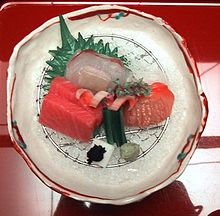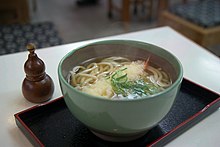Rice has been the staple food for the Japanese historically. Its fundamental importance is evident from the fact that the word for cooked rice, gohan and meshi, also stands for a "meal". While rice has a long history of cultivation in Japan, its use as a staple has not been universal. Notably, in northern areas (northern Honshū and Hokkaidō), other grain such as wheat were more common into the 19th century.
In most of Japan, rice used to be consumed for almost every meal, and
although a 2007 survey showed that 70% of Japanese still eat it once or
twice a day, its popularity is now declining. In the 20th century there
has been a shift in dietary habits, with an increasing number of people
choosing wheat based products (such as bread and noodles) over rice.
Japanese
rice is short-grained and becomes sticky when cooked. Most
rice is sold as hakumai ("white rice"), with the outer portion of the
grains (nuka) polished away. Unpolished brown rice (genmai) is
considered less desirable, but its popularity has been increasing in
recent years.
























